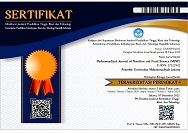Body Mass Index and Waist Circumferences Related to Uric Acid Level among Adults
Abstract
Keywords
Full Text:
PDFReferences
Newcombe DS. Uric Acid Metabolism in Humans. In: Gout: Basic Science and Clinical Practice. London: Springer-Verlag;
Manfredi JP, Holmes EW. Purine salvage pathways in myocardium. Annu Rev Physiol. Annual Reviews 4139 El Camino Way, PO Box 10139, Palo Alto, CA 94303-0139, USA; 1985;47(1):691–705.
Dianati NA. Gout and hyperuricemia. J Major. 2015;4(3):82–9.
Astuti STW, Tjahjono HD. Faktor-Faktor Yang Memengaruhi Kadar Asam Urat (Gout) pada Laki-Laki Dewasa di Rt 04 Rw 03 Simomulyo Baru Surabaya. Keperawatan. 2018;3(2).
Gibson RS. Principles of Nutritional Assessment. Oxford University Press; 2005.
Kementerian Kesehatan Republik Indonesia. Pedoman Gizi Seimbang. 2014 p. 1–99.
World Health Organisation (WHO). WHO | Waist Circumference and Waist–Hip Ratio. Report of a WHO Expert Consultation. Geneva, 8-11 December 2008. 2008;(December):8–11. Available from: http://www.who.int
de Oliveira E, Burini R. High plasma uric acid concentration: Causes and consequences. Diabetol Metab Syndr. 2012 Apr 4;4:12.
de Oliveira RB, Liabeuf S, Okazaki H, Lenglet A, Desjardins L, Lemke H-D, et al. The clinical impact of plasma leptin levels in a cohort of chronic kidney disease patients. Clin Kidney J [Internet]. 2012/01/01. Oxford University Press; 2013 Feb;6(1):63–70. Available from: https://pubmed.ncbi.nlm.nih.gov/27818752
Lin W-Y, Lung C-C, Liu T-S, Jian Z-H, Ko P-C, Huang J-Y, et al. The association of anthropometry indices with gout in Taiwanese men. BMC Endocr Disord [Internet]. 2013;13(1):30. Available from: https://doi.org/10.1186/1472-6823-13-30
DOI: https://doi.org/10.24853/mjnf.1.1.31-34
Refbacks
- There are currently no refbacks.
Indexed by:
Ciptaan disebarluaskan di bawah Lisensi Creative Commons Atribusi-NonKomersial 4.0 Internasional.
Copyright of Muhammadiyah Journal of Nutrition and Food Science (e issn: 2722-2942)












14.jpg)
